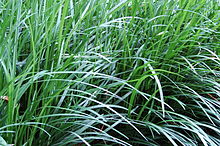- Ophiopogon
-
Ophiopogon 
Ophiopogon Japonicus Scientific classification 
Kingdom: Plantae clade: Angiosperms clade: Monocots Order: Asparagales Family: Asparagaceae Subfamily: Nolinoideae Genus: Ophiopogon
Ker Gawl.Species See text
Ophiopogon is a genus of herbaceous perennial plants with about 65 species, native to warm temperate to tropical east, southeast, and south Asia. The name of the genus is derived from Greek Όφις ophis, "snake", and πόγὦν pogon, "beard", most probably referring to its leaves and its tuffed growth.[1][2][3][4] In the APG III classification system, it is placed in the family Asparagaceae, subfamily Nolinoideae (formerly the family Ruscaceae).[5] Like many lilioid monocots, it was formerly classified in the Liliaceae.
They grow from short rhizomes, and bear tufts of leaves, from which flowers emerge in racemes held on short stems above the leaves.
- Selected species
- Ophiopogon albimarginatus
- Ophiopogon amblyphyllus
- Ophiopogon angustifoliatus
- Ophiopogon bockianus
- Ophiopogon bodinieri
- Ophiopogon chingii
- Ophiopogon clarkei
- Ophiopogon clavatus
- Ophiopogon corifolius
- Ophiopogon dracaenoides
- Ophiopogon filipes
- Ophiopogon fooningensis
- Ophiopogon grandis
- Ophiopogon heterandrus
- Ophiopogon hongjiangensis
- Ophiopogon intermedius
- Ophiopogon jaburan
- Ophiopogon japonicus
- Ophiopogon jiangchengensis
- Ophiopogon latifolius
- Ophiopogon lushuiensis
- Ophiopogon mairei
- Ophiopogon marmoratus
- Ophiopogon megalanthus
- Ophiopogon menglianensis
- Ophiopogon motouensis
- Ophiopogon multiflorus
- Ophiopogon ogisui
- Ophiopogon paniculatus
- Ophiopogon peliosanthoides
- Ophiopogon pingbienensis
- Ophiopogon planiscapus
- Ophiopogon platyphyllus
- Ophiopogon pseudotonkinensis
- Ophiopogon reptans
- Ophiopogon reversus
- Ophiopogon revolutus
- Ophiopogon sarmentosus
- Ophiopogon sinensis
- Ophiopogon sparsiflorus
- Ophiopogon stenophyllus
- Ophiopogon sylvicola
- Ophiopogon szechuanensis
- Ophiopogon tienensis
- Ophiopogon tonkinensis
- Ophiopogon tsaii
- Ophiopogon umbraticola
- Ophiopogon xylorrhizus
- Ophiopogon yunnanensis
- Ophiopogon zingiberaceus
Cultivation and uses
Some species such as Ophiopogon japonicus and Ophiopogon planiscapus are used as ground cover plants.
In Chinese medicine the tuber of Ophiopogon japonicus, known as mai men dong, is the cardinal herb for yin deficiency. According to the Chinese Herbal Medicine Materia Medica, the herb is sweet, slightly bitter and slightly cold, enters the heart, lung and stomach channels and nourishes the yin of the stomach, spleen, heart and lungs and clears heat and quiets irritability. It is used for hacking dry coughs, dry tongue and mouth and constipation. Liriope (genus) is used as a substitute.[6]
References
- ^ Germplasm Resources Information Network: Ophiopogon
- ^ Flora of China: Ophiopogon
- ^ Huxley, A., ed. (1992). New RHS Dictionary of Gardening. Macmillan ISBN 0-333-47494-5.
- ^ When Perennials Bloom: An Almanac for Planning and Planting By Tomasz Aniśko pg 342
- ^ Chase, M.W.; Reveal, J.L. & Fay, M.F. (2009), "A subfamilial classification for the expanded asparagalean families Amaryllidaceae, Asparagaceae and Xanthorrhoeaceae", Botanical Journal of the Linnean Society 161 (2): 132–136, doi:10.1111/j.1095-8339.2009.00999.x
- ^ Bensky, D., Clavey, S., Stoger, E., & Gamble, A. (2004). Chinese Herbal Medicine Materia Medica, third edition. Eastland Press.
Categories:- Asparagaceae genera
- Nolinoideae
- Garden plants of Asia
- Groundcovers
- Grasses
Wikimedia Foundation. 2010.
